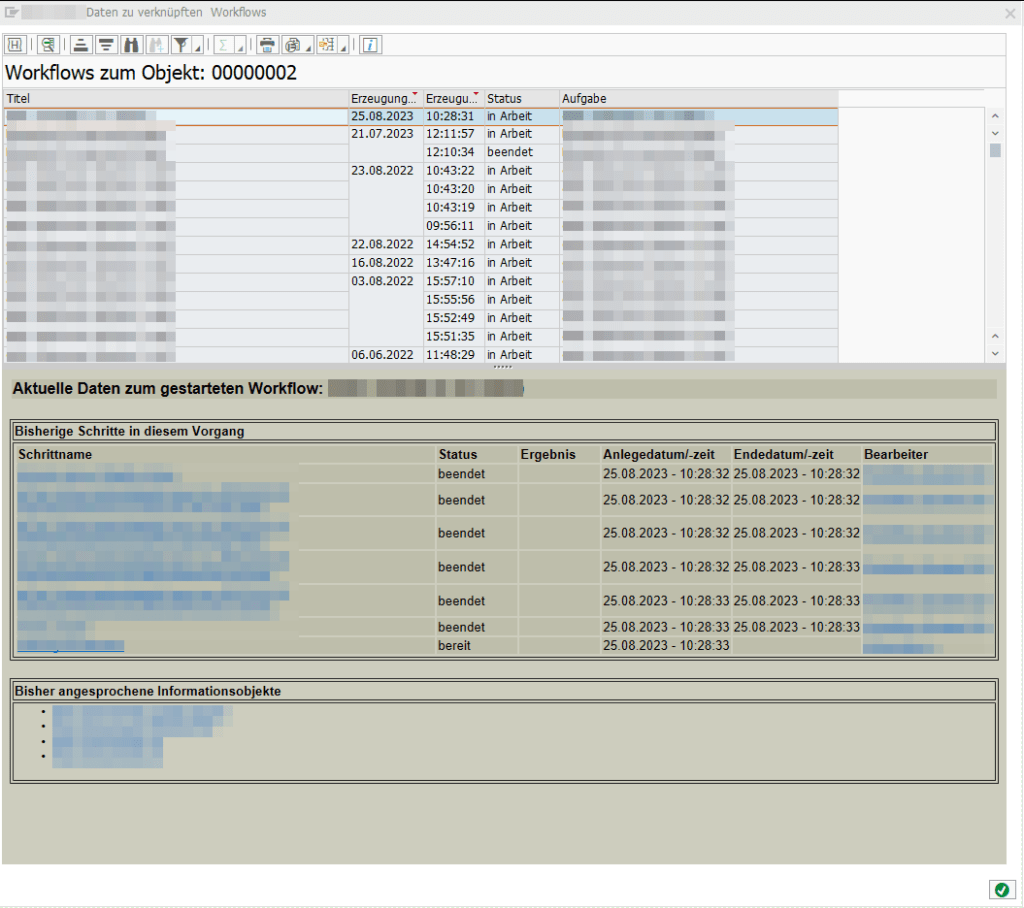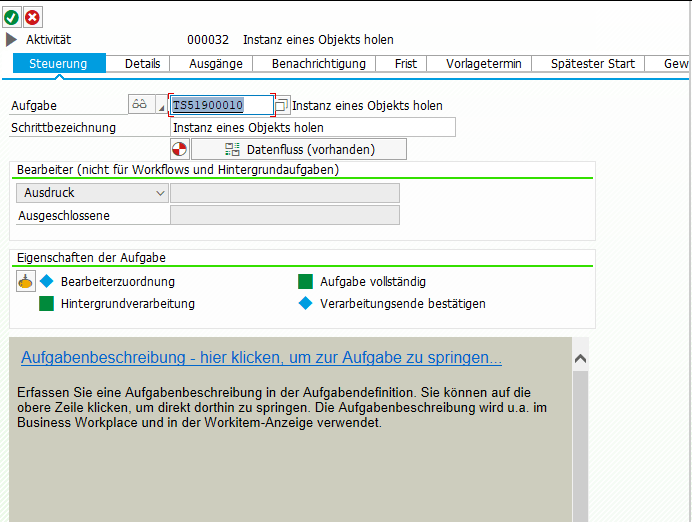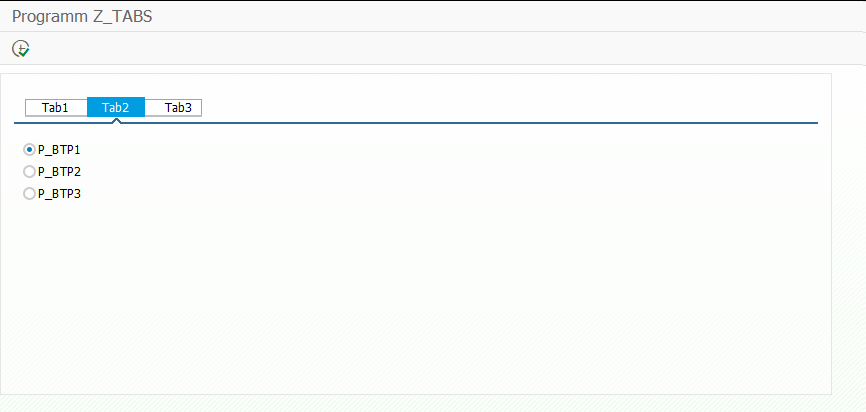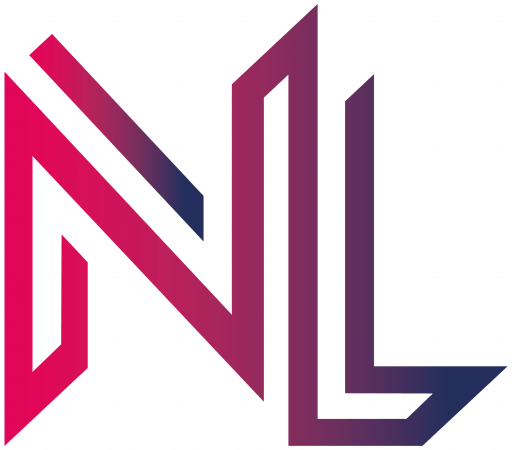DATA(work_schedule) = cl_hcmfab_employee_api=>get_instance( )->get_work_schedule( iv_pernr = 1
iv_begda = sy-datum
iv_endda = sy-datum ).
cl_demo_output=>display_data( work_schedule ).
Category: ABAP
ABAP
[Workflow] Display all Workflows related to an Employee
PA20 – Workflow-Overview


To attach your own workflow in this overview, you have to add the Task TS51900010 to your workflow and pass over the employee number to the Business Object “Employee” (BUS1065)


[ABAP] Validate JSON data
While searching on how to validate a given JSON string, I found two options. The first simply returns a Boolean value, the second also returns information about what could be wrong.
DATA(lv_json) = '{'
&& '"employee": {'
&& |"name" : "Max", |
&& |"age" : 43, |
&& '}'
&& '}'.
" option 1:
DATA(is_valid) = /ui5/cl_json_util=>is_wellformed( lv_json ).
" option 2:
DATA(lo_reader) = cl_sxml_string_reader=>create( cl_abap_codepage=>convert_to( lv_json ) ).
TRY.
lo_reader->next_node( ).
lo_reader->skip_node( ).
CATCH cx_sxml_parse_error INTO DATA(lx_parse_error).
WRITE lx_parse_error->get_text( ).
ENDTRY.
[ABAP] Generate a QR-Code
There are many blogs describing how to create a QR-Code in the context of SAPscript or Smartforms (e.g. here, here, here and here). But I was looking for a way to generate a QR-Code and only receive the graphical data stream from it, without the need for any manual steps such a creation via SE73. During my search, I found these two notes, which contained all the information I needed:
- 2790500: mentions the class CL_RSTX_BARCODE_RENDERER with method QR_CODE
- 2030263: describes the parameters for a QC-Code creation
Following my little test report:
PARAMETERS p_text TYPE string DEFAULT 'My QR-Code Content'.
DATA: lv_action TYPE i.
DATA: lv_filename TYPE string.
DATA: lv_fullpath TYPE string.
DATA: lv_path TYPE string.
TRY.
cl_rstx_barcode_renderer=>qr_code( EXPORTING i_module_size = 25 " Size of smallest module (in pixel, max: 32000)
i_barcode_text = p_text " Barcode text
* i_mode = 'A' " Mode ('N', 'A', 'L', 'B', 'K', 'U', '1', '2'; note 2030263)
* i_error_correction = 'H' " Error correction ('L', 'M', 'Q', 'H')
* i_rotation = 0 " Rotation (0, 90, 180 or 270)
IMPORTING e_bitmap = DATA(e_bitmap) ). " Bitmap in BMP format
DATA(lt_raw_data) = cl_bcs_convert=>xstring_to_solix( e_bitmap ).
" Save-Dialog
cl_gui_frontend_services=>file_save_dialog( EXPORTING default_file_name = 'QR-Code'
default_extension = 'bmp'
file_filter = |{ cl_gui_frontend_services=>filetype_all }|
CHANGING filename = lv_filename
path = lv_path
fullpath = lv_fullpath
user_action = lv_action ).
IF lv_action EQ cl_gui_frontend_services=>action_ok.
" Download file to disk
cl_gui_frontend_services=>gui_download( EXPORTING filename = lv_fullpath
filetype = 'BIN'
bin_filesize = xstrlen( e_bitmap )
CHANGING data_tab = lt_raw_data ).
ENDIF.
CATCH cx_rstx_barcode_renderer INTO DATA(lo_exp).
MESSAGE lo_exp->get_text( ) TYPE 'I'.
ENDTRY.
[ABAP] Progress indicator
SELECT * FROM sflight INTO TABLE @DATA(flights).
LOOP AT flights INTO DATA(flight).
WAIT UP TO 1 SECONDS.
cl_progress_indicator=>progress_indicate( i_text = |Processing flight { flight-connid } as { sy-tabix } / { lines( flights ) }|
i_processed = sy-tabix
i_total = lines( flights )
i_output_immediately = abap_true ).
ENDLOOP.

[ABAP] xsdbool
Somehow I always forget that there is a boolean function in ABAP. That’s why I’m writing this post to hopefully remember it better. 🙂
If you just want to check something for truthiness, you can do it in the following three ways:
IF sy-subrc = 0.
result = abap_true.
ELSE.
result = abap_false.
ENDIF.
result = SWITCH #( sy-subrc WHEN 0 THEN abap_true
ELSE abap_false ).
result = xsdbool( sy-subrc = 0 )
[ABAP] SALV – Access column name
TRY.
cl_salv_table=>factory( IMPORTING r_salv_table = DATA(lo_alv)
CHANGING t_table = lt_output ).
CATCH cx_salv_msg INTO DATA(lx_salv).
WRITE: / lx_salv->get_text( ).
ENDTRY.
DATA(columns) = lo_alv->get_columns( ).
DATA(lt_cols) = columns->get( ).
LOOP AT lt_cols INTO DATA(ls_cols).
DATA(lo_column) = ls_cols-r_column.
CASE ls_cols-columnname.
WHEN 'MANDT'
lo_column->set_visible( abap_false ).
ENDCASE.
ENDLOOP.
[ABAP] convert string to xstring and convert back
DATA(lv_string) = |My string I want to convert to xstring.|.
TRY.
DATA(lv_xstring) = cl_abap_codepage=>convert_to( lv_string ).
DATA(lv_string_decoded) = cl_abap_codepage=>convert_from( lv_xstring ).
WRITE: / lv_string,
/ lv_xstring,
/ lv_string_decoded.
CATCH cx_root INTO DATA(e).
WRITE: / e->get_text( ).
ENDTRY.
[ABAP] Filter table using VALUE FOR
DATA(lt_result) = VALUE z_type( FOR line IN lt_table
WHERE ( value IN lr_values )
( field = line-value ) ).
[ABAP] Selection Screen Tabbed Block

SELECTION-SCREEN BEGIN OF BLOCK bl4 WITH FRAME TITLE TEXT-t01.
SELECTION-SCREEN BEGIN OF TABBED BLOCK tbl FOR 10 LINES.
SELECTION-SCREEN TAB (15) tbl_tab1 USER-COMMAND tab1 DEFAULT SCREEN 1001.
SELECTION-SCREEN TAB (15) tbl_tab2 USER-COMMAND tab2 DEFAULT SCREEN 1002.
SELECTION-SCREEN TAB (15) tbl_tab3 USER-COMMAND tab3 DEFAULT SCREEN 1003.
SELECTION-SCREEN END OF BLOCK tbl.
SELECTION-SCREEN END OF BLOCK bl4.
* Subscreen 1001 Tab1
SELECTION-SCREEN BEGIN OF SCREEN 1001 AS SUBSCREEN.
PARAMETERS p_bool1 TYPE abap_bool AS CHECKBOX.
SELECTION-SCREEN END OF SCREEN 1001.
* Subscreen 1002 Tab2
SELECTION-SCREEN BEGIN OF SCREEN 1002 AS SUBSCREEN.
PARAMETERS p_btp1 TYPE flag RADIOBUTTON GROUP rbg DEFAULT 'X'.
PARAMETERS p_btp2 TYPE flag RADIOBUTTON GROUP rbg.
PARAMETERS p_btp3 TYPE flag RADIOBUTTON GROUP rbg.
SELECTION-SCREEN END OF SCREEN 1002.
* Subscreen 1003 Tab3
SELECTION-SCREEN BEGIN OF SCREEN 1003 AS SUBSCREEN.
PARAMETERS p_bool2 TYPE flag AS CHECKBOX.
SELECTION-SCREEN END OF SCREEN 1003.
INITIALIZATION.
" provide tab names
tbl_tab1 = 'Tab1'.
tbl_tab2 = 'Tab2'.
tbl_tab3 = 'Tab3'.
" set active tab (activetab value must be in uppercase)
tbl-activetab = 'TAB2'.
tbl-dynnr = 1002.
tbl-prog = sy-repid.
AT SELECTION-SCREEN.
" click on tabstrip event
CASE sy-ucomm.
WHEN 'TAB1'.
MESSAGE 'TAB1' TYPE 'S'.
WHEN 'TAB2'.
MESSAGE 'TAB2' TYPE 'S'.
WHEN 'TAB3'.
MESSAGE 'TAB3' TYPE 'S'.
ENDCASE.
